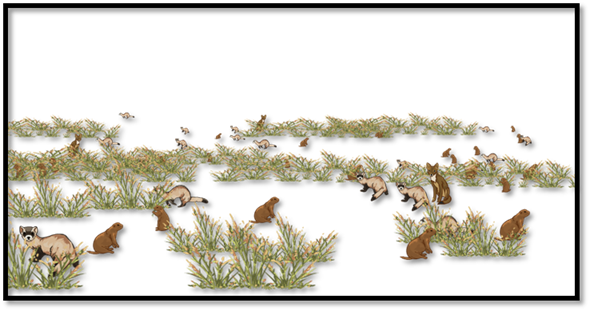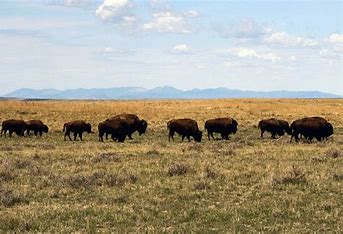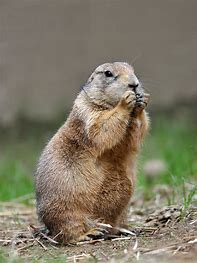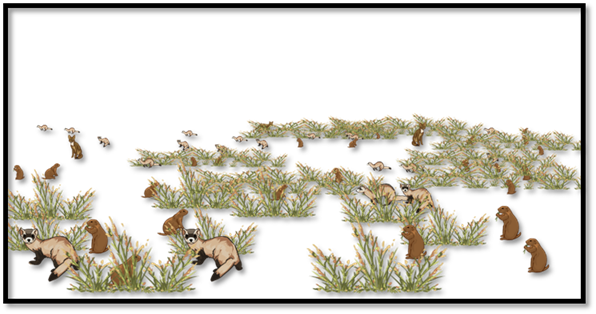Prairie
Ecosystem - Gizmos

You will need a username and password
from Gizmos to complete the Student Exploration.
Please get in touch with your teacher
for these credentials.
Learning
Objectives
Students will:
·
Identify the producer in an ecosystem.
·
Classify consumers as herbivores or carnivores.
·
Investigate the interdependence of the organisms in an
ecosystem.
·
Determine what each organism eats based on the results of
experiments.
·
Explore the long-term effects of changes to the ecosystem.
Vocabulary:
Prairie Ecosystem
Carnivore – an organism that
eats only animals.
·
Examples of carnivores in North America are wolves, coyotes,
mountain lions, hawks, eagles, and snakes.
Consumer – a creature that
feeds on organic matter because it cannot produce it.
·
All animals, all fungi, and even a few plants are consumers.
·
A cow chewing grass, a person eating steak, and an earthworm
digesting manure represents consumers in action because, in each case, the
animal is eating organic matter.
Ecosystem – a community of
living things along with their natural environment.
Equilibrium – a state of balance
and stability.
Extinct – no longer in
existence. (An organism is extinct if it has died out.)
Food
chain
– a sequence of organisms in which each organism feeds on the one below.
·
Example: Grass à Cricket à Frog à Snake à Hawk.
·
In this food chain, crickets eat grass, frogs eat crickets,
snakes eat frogs, and hawks eat snakes.
Herbivore – an animal that eats
plants.
·
Examples of herbivores in North America are deer, elk, bison,
beavers, and crickets.
Organism – a living thing.
Population – all the organisms of
a certain kind in a particular place.
Prairie is a flat or gently
hilly land dominated by grasses and has few or no trees.
·
The word "prairie" generally refers to an area of
North America east of the Rocky Mountains.
Producer – an organism that can
convert simple inorganic matter (such as water and carbon dioxide) into organic
matter (like sugar and protein).
·
Plants are producers because they use the energy of the Sun to
create organic materials from carbon dioxide and water.
Scientific
Background
An ecosystem
combines the living and non-living elements of a particular environment. An
ecosystem consists of two parts:
·
Community – all the living
things, or organisms, in the ecosystem.
·
Habitat – the physical
environment, including the landscape, soils, water, and climate.
Within an ecosystem, each organism interacts
with other organisms. One of the simplest types of interactions occurs when one
organism eats another. Food chains
can represent feeding relationships. In a food chain, each organism eats one
other organism. Food chains generally begin with producers, organisms that don't depend on other organisms for
energy. The most familiar producers are plants, which generate energy from the
Sun. Organisms that rely on other organisms for energy are called consumers. Herbivores are consumers that eat plants, carnivores eat animals, and omnivores
eat plants and animals.
The food chain in the Prairie Ecosystem Gizmo
is Grass à Prairie dog à Ferret à Fox. Changes to the
population of any organism in the food chain will affect the others. For
example, removing prairie dogs will increase the grass population and decrease
the ferret and fox populations. Removing ferrets will hurt foxes, help prairie
dogs, and hurt the grass.
Of course, real ecosystems are much more
complex. Food webs are diagrams that
show all the food sources for each type of organism.
Environmental
Connection
The American prairie was once a great grassland
stretching from the Rocky Mountains to Indiana, from Texas to central Canada.
Native grasses adapted to frequent droughts by growing deep root systems to
extract moisture from the soil. When European-American settlers first started
exploring the region, there were as many as 50 million bison (commonly called
buffalo) and over a billion prairie dogs living on the prairie.

But rich prairie soils are also prime
agricultural land, and since the late 1800s, much of the prairie has been
fenced off and converted to farms and ranches. During the 1870s, the great
bison herds were systematically slaughtered until only 25 bison remained alive
in 1894. Species such as pronghorns, prairie dogs, and burrowing owls declined
due to hunting, poisoning, and habitat loss. The black-footed ferret population
was reduced to only 18 animals by 1986. Today less than 2% of North America's
original 3.6 million square kilometers (1.4 million square miles) of prairie
are undisturbed.

Today many prairie species are making a
comeback. Bison now number over 500,000, and about 700 black-footed ferrets are
in the wild. Agricultural scientists are finding ways to convert annual crops, such
as wheat, sunflowers, and sorghum, into perennials with deep root systems that
reduce soil loss. The prairie will never be the same as it once was, but with
attention and care, what is left can be preserved.
Gizmo
Overview
In the Prairie Ecosystem Gizmo, you will
investigate life in a prairie dog town. In this simplified ecosystem, prairie
dogs eat grass, ferrets eat prairie dogs, and foxes eat ferrets. You can alter
any population and then play the simulation to see how populations respond to
the change.
The Student Exploration sheet contains three
activities:
Ø Activity A – You will investigate how grass availability affects the other
populations.
Ø Activity B – You will determine what each animal eats and display that
information in a food chain.
Ø Activity C – You will investigate the long-term effects of sudden changes
to the ecosystem.
Getting Started with Gizmos
Class: SCI Science 150
Step 1: Go to Join Class | Gizmos
Step 2: Type in your teacher’s class code: EL9QCBDW
Click “Next” to continue.
Step 3: If you’ve used Gizmos before and remember your login information, log into your account. Otherwise create a new account.
Step 4: Write down your username and password and put this sheet in your class notebook.
username: ________________________
password: ________________________
Congratulations! Now that you’re enrolled, you can log into your Gizmos account at go-el.com using your username and password.
Click the image below to begin your
exploration.
